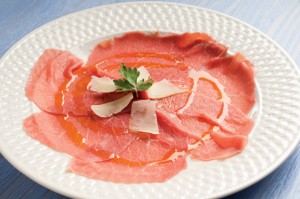With a cold brew in your left hand and a pair of metal tongs in your right, you peer down at the sizzling meat below. Careful not to let the smoke get in your eyes, you lift the meat gently off the flame and wonder—is it done yet? That’s an important question. An even better one is, why are you cooking that meat at all? You can eat raw meat. And if your eyes can get beyond the initial shock, your taste buds will be rewarded. So give your grill a rest, and check out our no-brainer, no-cook rawcipes.
by Michael Estrin
CEVICHE
If you think raw meat is a little too exotic, seafood’s the place to start. If you like sushi—and not just the artery-clogging, tempura-battered goodness rolls that feature Japanese mainstays such as cream cheese and jalapeños—you’re ready for ceviche, a Latin presentation of fish “cooked” in citrus juice.
• Select the freshest saltwater fish you can find—albacore tuna, sole, snapper and halibut all work well. Remove the bones and cut the fish into pieces about the size of a quarter.
• For 1 pound of fish, you’ll need two cups of liquid. Traditional ceviche uses lime juice, but any citric acid can work—and you can even add a splash of beer. Like the liquid, spices are up to the chef, but cilantro, hot sauce and chopped chiles are all great ways to give your ceviche a unique flavor. Include finely chopped onions or opt for a less traditional flavor like ginger, and you’ll be on solid ground.
• Combine the fish, citrus juice and your choice of additions in a non-reactive dish. Cover, refrigerate and let the fish marinate at least three hours, stirring occasionally, before serving cold with a Latin beer like Grupo Modelo Victoria.
CARPACCIO
The key to carpaccio—a raw meat starter born in Italy—is to slice your protein as thin as possible, and serve it fresh. Tuna, veal and venison are all strong choices, but the classic carpaccio is beef.
• Start with 1 pound of beef tenderloin, trimmed of fat and sinew, and sliced extremely thin. If you cut the meat yourself, you’ll want to pound it thin, but be careful not to break the beef’s fibers; or, employ a butcher’s help. Either way, only prepare the protein the day you plan to eat it, and assemble the dish just before serving.
• Arrange the meat on a serving platter and sprinkle with salt and pepper to taste. Drizzle the meat with high-quality olive oil and the juice of two lemons. Scatter capers, arugula or Parmesan cheese over the meat, or try parsley or basil. And if you’re feeling decadent, add a little truffle oil.
• Serve the carpaccio platter alone or with toasted baguette slices, and pay homage to the dish’s origins by pairing it with Peroni.
KIBBE
A traditional Lebanese dish popular throughout the Middle East, kibbe consists of raw beef (or lamb) mixed with cracked (or bulgur) wheat and spices. But don’t worry about changing up some of the dry ingredients; the basics make it kibbe, spicing it up makes it your own.
• Soak 2 1/2 cups of fine-cracked (bulgur) wheat according to the instructions on the box. Meanwhile, finely grate 2 large onions.
• When the wheat is ready, combine it with 2 pounds of finely ground lamb or beef, the grated onions, 1 tablespoon salt, 1 teaspoon black pepper, 1/2 teaspoon red pepper and 1/4 teaspoon cinnamon. Mix the kibbe with your hands by gently squeezing the mixture through your fingers. Dipping your hands often into a bowl of ice water will keep them wet and cool, and your kibbe moist.
• Finished kibbe looks like a raw meatloaf; refrigerate it for an hour or two to let it settle. Garnish with extra-virgin olive oil and serve with warm pita bread and, if you can find it, Almaza beer.
Safety First: Wash your hands, wash your tools, and keep meat refrigerated! Can you say more about food safety and raw meat? Sure. But if you wash your hands before and after touching the meat, avoid cross-contamination (hint: don’t chop veggies on the same cutting board you use for raw meat), and hold the food in the fridge until serving, you’re golden.

